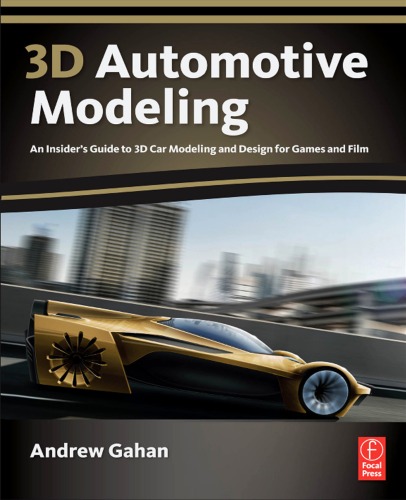

Most ebook files are in PDF format, so you can easily read them using various software such as Foxit Reader or directly on the Google Chrome browser.
Some ebook files are released by publishers in other formats such as .awz, .mobi, .epub, .fb2, etc. You may need to install specific software to read these formats on mobile/PC, such as Calibre.
Please read the tutorial at this link. https://ebooknice.com/page/post?id=faq
We offer FREE conversion to the popular formats you request; however, this may take some time. Therefore, right after payment, please email us, and we will try to provide the service as quickly as possible.
For some exceptional file formats or broken links (if any), please refrain from opening any disputes. Instead, email us first, and we will try to assist within a maximum of 6 hours.
EbookNice Team

Status:
Available5.0
40 reviews
ISBN 10: 0240814282
ISBN 13: 9780240814285
Author: Andrew Gahan
Master techniques from top automotive designers and world-class game developers with this insider's guide to designing and modeling 3D vehicles. With techniques demonstrated in 3ds Max, Maya, XSI, and Photoshop, "3D Automotive Modeling" starts with a fantastic series of hot concept designs and continues by offering a full hands-on modeling tutorial for each. Some of the very best designers and modelers from across the globe take you through their processes step-by-step, giving you the tips, tricks, and short-cuts that true professionals use. "3D Automotive Modeling" features tutorials from Honda, Toyota, and Mercedes-Benz designers, as well as modelers from Sony Computer Entertainment, Lucas Arts, and Simbin-artists who have worked on some of the biggest games in the industry, including the MotorStorm series. You will get: insider tips from a team of noted professionals, led by author Andrew Gahan, part of the award-winning game team behind the PlayStation 3 smash hit series, MotorStorm; all tutorial files, models, textures, blueprints, and concept images on the associated web site; and, access to a vibrant forum on the web site where you can discuss and share your work and get feedback from the pros.
Chapter 1 Duster Concept
Initial Idea
Design
Concept
Chapter 2 Modeling the DUSTER in 3ds Max
Chapter 3 Chicago-Styled Hot Rod Concept
The Design Process
Chapter 4 Modeling the Chicago-Styled Hot Rod
Modeling
Step 1
Step 2
Step 3
Step 4
Step 5
Step 6
Step 7
Step 8
Step 9
Step 10
Step 11
Step 12
Step 13
Step 14
Step 15
Step 16
Step 17
Step 18
Step 19
Step 20
Step 21
Step 22
Step 23
Step 24
Step 25
Step 26
Step 27
Step 28
Step 29
Step 30
Step 31
Step 32
Step 33
Step 34
Step 35
Step 36
Step 37
Step 38
Step 39
Step 40
Step 41
Step 42
Step 43
Step 44
Step 45
Step 46
Step 47
Step 48
Step 49
Step 50
Step 51
Step 52
Step 53
Step 54
Step 55
Step 56
Step 57
Step 58
Step 59
Step 60
Step 61
Step 62
Step 63
UV Unwrapping
Step 64
Step 65
Step 66
Step 67
Step 68
Step 69
Step 70
Step 71
Step 72
Step 73
Texture Mapping
Step 74
Step 75
Step 76
Step 77
Step 78
Step 79
Step 80
Step 81
Step 82
Step 83
Step 84
Step 85
Step 86
Step 87
Step 88
Step 89
Step 90
Step 91
Step 92
Step 93
Step 94
Step 95
Step 96
Step 97
Step 98
Step 99
Step 100
Step 101
Step 102
Step 103
Step 104
Step 105
Step 106
Step 107
Step 108
Step 109
Step 110
Step 111
Step 112
Step 113
Step 114
Step 115
Step 116
Step 117
Step 118
Step 119
Chapter 5 Team Hizashi Racing Concept
Part 1 Inspiration
Introduction
Notes on Workflow
Concept Behind the Ideas
Keeping a Log of Ideas
Overall Feeling
Ideas for My Concept
Part 2 Initial Ideas
Which Tools?
Staying Focused and Organized!
Rough Sketches
Work-out Drawings
Part 3 Sketching Out Your Concepts
Using Underlays from a Photograph
Creating Your Own Underlays
Tips for Sketching
Part 4 Rendering and Layouts
Preparing Images—Scanning and Retouching
Checking and Modifying Perspective
Basic Rendering
Advanced Rendering
Part 5 Wireframe Modeling
Why Build a Wireframe Model?
Starting Point—Importing the Side View
Wheels, Centerline, Plan
Viewing the Wireframe
Editing Scale and Proportions
Detailing
Keep Going!
Part 6 Creating Blueprints
Flattening the Wireframe
Trimming Curves
Import/Export Options
Sign off
Chapter 6 Team Hizashi Racing Concept—From CAD to Complete
Introduction
Modeling process vs. design process
Preparing to Start
Know your specifications
Reference material
Tips
Softimage tools/functions
Preparing the reference scene
Learning the Basics of Softimage XSI—Creation of a Wheel
Front wheel—4,500 polygons
In summary
Creation of the Body
The subdivision method
Planning—draw a wireframe
Working with the CAD
Starting the body
Before starting the fake bevels
Chapter 7 Gallery
Chapter 8 A Photogrammetric Vehicle Pipeline
Introduction
Photogrammetry
Shooting the Footage
Photogrammetry
Importing into Maya
Basic Modeling
Speed Things Up with MEL
UV Groups
Projecting the Textures
Other Texturing Methods
Ambient occlusion layer
UV layer
Index layer
Specular map
Displacement map
Conclusion
Recommended Reading
Recommended Websites
Chapter 9 Vortex Concept
Initial Idea
Theme
Ortho
Final
Chapter 10 Vortex Modeling in Maya
Vortex Texturing
Step 1
Step 2
Step 3
Step 4
Step 5
Step 6
Step 7
Step 8
Step 9
Step 10
Step 11
Step 12
Step 13
Step 14
Step 15
Step 16
Step 17
Step 18
Step 19
Chapter 11 Mobile Suit Concept
Shape Generation
Choosing My Direction
Refining the Shape
Adding Form
Control Pod
Armored Panels
Blending
Contrast
Suit Development
Putting It in Perspective
Tidying the Sketch
Blocking In
Cheat Shading
Light Source
Sharper Shadows
Simple Background
Value Adjustments
Color Base
Sharpening Edges
Painting Freehand
Hidden Mechanics
Control Pod
Adding the Lights
Light Reflection
Scuffed Armor
Graphics
Adding FX
Final Touches
Chapter 12 Modeling the Mobile Suit
Index
automotive 3d modeling
3d automotive design
3d modeling ebook
a 3d book
a 3d car
3d modeling a car
Tags: Andrew Gahan, Automotive, Modeling